|
Navigation
BOT4404
Main Page
FIU
Home
FIU
Marine Biology Home
Dept.
Biology Home
Frank
Jochem Home
E-Mail
|
Charophyceae
-
Ancestral
line of algae leading to higher land plants
-
Three
major groups
-
Charales:
macroscopic, complex freshwater algae
-
Coleochaetales:
flat, disc-like, epiphytic thalli
-
Zygnematales:
filamentous forms and desmids
-
Early
divergent forms include the flagellate Mesostigma
(possess organic scales, often classified in the Prasinophyceae), the sarcinoid
Chlorokybus
(several round cells in a common miclage, rare), and the filamentous Klebsormidium
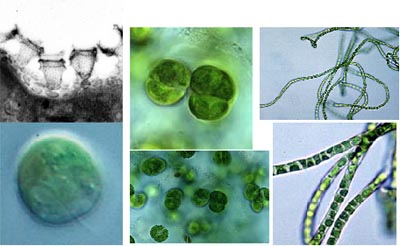
left column: Mesostigma (lower) and scales on
cell surface; middle column: Chlorokybus; right column: Klebsormidium
(four left and lower right photograph courtesy of Charles F. Delwiche,
University of Maryland; more information on Charophycean algae at http://www.life.umd.edu/labs/delwiche/Charophyte.html)
Zygnematales
-
Named
after the genus Zygnema
-
Abundant
in various freshwaters (ponds, lakes, slow streams)
-
Appearance
as filaments and the ornamented desmids
-
Filaments
often form slimy patches on the surface, buoyancy provided by oxygen bubbles
from photosynthesis captured in mucilage; or attached mats
-
Filamentous
species Zygnema and Mougeotia can change
their plastid orientation in response to light
intensity
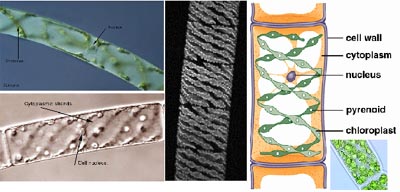
The filamentous Zygnematales alga Spirogyra
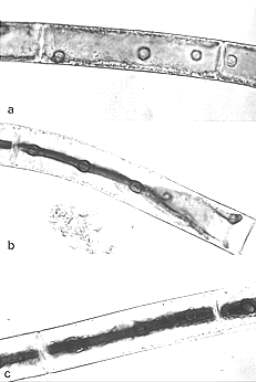 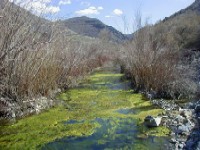
The orientation of chloroplasts in the genus Mougeotia
is changed according to the light regime; low light as in the upper filament,
high light as in the lower filament; Right: filamentous Zygnematales can
form slimy scum on the surface of eutrophied freshwaters
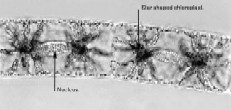 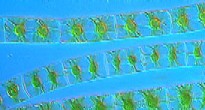
The genus Zygnema possesses star-shaped plastids
that can be contracted upon high light intensities (compare upper and middle
filament in the right picture)
-
Desmids
occur in pristine, acidic lakes with low nutrient concentration; they have
high phosphorus storage capacities; desmids possess a pore-containing,
two-part cell wall separated by a narrow isthmus („placoderm“ desmids)
-
Extensive
mucilage is excreted through the cell wall
by flask-shaped pores
  
 
-
Mucilage
prisms can often be seen from excreted mucilage
of adjacent pores
-
Cell
motility in desmids is due to mucilage excretion;
a „slime trail“ can be visualized under the microscope by ink preparations;
swelling of the mucilage by water pushes cells forward
-
Asexual
reproduction by cell division, typically during
the dark period
-
Mitosis
is open and centrioles are absent
-
Chloroplast
divides by contriction and vacuole forms to separate daughter chloroplasts;
plastid division is completed after daughter cells separate
-
Nucleus
moves aside the isthmus to give way to material transport to build a new
semicell; movement probably by microtubuli arrangement
-
New semicell
is identical mirror-image of older semicell
-
Semicells
in desmids are of different age!
-
Phragmoplast:
desmids lack a phragmoplast; the filamentous forms possess a phragmoplast
but not plasmadesmata such as the higher charophytes
-
Sexual
reproduction does not involve flagellated
gametes
-
Scalariform
conjugation is the fusion of nonflagellate
gametic thallus cells by lateral plasma connections (conjugation tubes);
both gametes might move into the conjugation tube to form a zygote „between“
the filaments (Mougeotia), or only one cell moves through the conjugation
tube towards the other cell (Spirogyra)
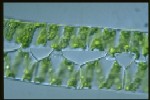 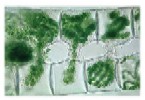
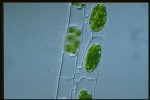 
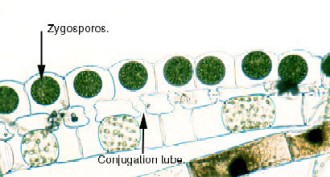
Conjugation stages in Spirogyra; only one protoplast
moves into the opposite filament, the zygotes develop in one filament
-
Desmids
form their conjugation tube in the isthmus region; cells aggregate by pheromon
attraction
-
Zygotes
are thick-walled, orange-brown, and diploid; meiosis occurs upon germination
-
Desmid
cells originating from zygotes (gones)
do not resemble vegetative cells yet
Coleochatales
-
Characteristic
genus: Coleochaete (gr. Koelos
= sheath, chaite = hair)
-
Sheated
hairs: extensions of cell wall enclose plasma,
can reach 100 times the length of the cell; base of the hair is thickened;
sheated hairs are unique to this group
-
Seta
cells produce hairs; only 3-5% of thallus
cells in Coleochaete; possess C-shaped plastid and rotate
See
video stream of rotating seta cells in the thallus here (405 kB)
See
video stream of rotating single seta cell here (544 kB)
-
Thallus
is pseudoparenchymatous with marginal meristem
-
Asexual
reproduction by biflagellate zoospores with
organic scales but without eye-spots
-
Sexual
reproduction by oogamy; sperms are naked and
colorless; egg cells produce trichgyne
for fertilization
-
Zygotes
are smooth-walled and not released; a layer of vegetative cells growth
around and nurishes the zygote
-
Germination:
multiple mitotic, flagellated meiospores, which settle for further growth
Charales – the Stoneworts
-
Characteristic
genus: Chara
-
Occurrence
as extensives meadows in lakes and streams with low phosphate concentrations
-
Calcification
colores some species whitish
-
Branched
filaments differentiated in apex, nodes, basal
region
-
Single
apical mestematic cell responsible for length
growth; the immediate derviative of apical cell division divides transversely;
the upper of these two cells forms a node for branches, the lower one forms
a long (up to 15 cm) internodal cell
without further division
-
Internodal
cells can posses up to 1000 nuclei; cytoplasmic
streaming for mixing and long-distance transport within the large cells
-
Cell
plate between nodal and internodal cells with
large pores from secondary plasmadesmata
-
Plant-like
phragmoplast is present during cell division
-
Asexual
reproduction by bulbils = white spherical
or star-shaped structure on rhizoids; dispersial and perennation
-
Sexual
reproduction by oogamy
with two types of gametangia
-
Gametangia
possess protective, nonreproductive layers of cells for protection and
originate from node cells
-
Antheridia
produce biflagellated spermatozoids; mature antheridia are bright orange
due to carotene in an outer layer of cells (shield cells); primary capitulum
cells (8) produce long strings of small cells, each of them producing one
spermatozoid
-
Ooginia
produce a single egg cell, enclosed by tube
cells (laterally) and 1-2 crown
cells (top)
-
Zygote
with thick, dark-brown wall; tube cells calcify; zygote released upon decay
of mother thallus together with calcified tube cell shield
-
Germination:
meiosis, but probably only one cell surviving; growth of a colorless protonema,
which attaches to substrate and produces colored cells at is apical end
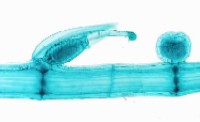
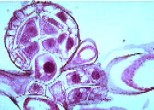 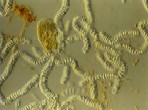
Left: thin section through a Chara antheridium,
note
the layer of non-reproductive cells around the inner
reproductive cells; right: spermatozoids in long strings
of spermatozoid-producing cells from an antheridium
|

Different desmids
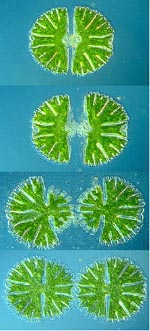
Cell division sequence in the desmid Micrasterias
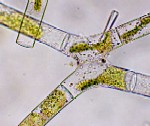
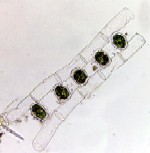
Conjugation in Mougeotia: both cell protoplasts
move into the conjugation tube, the zygotes develop "between" the two filaments
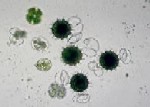
Zygotes of the desmid Micrasterias


Upper: Chara sp.; middle: Nitella
sp. (courtesy of Charles F. Delwiche, University of Maryland); lower: thin
section through the apical meristem cell of Chara
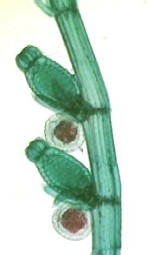
Oogonia (elongated) and antheridia (round) can occur
at the same node (above) or at different nodes (left), depending on the
Chara
species

Mature antheridia appear orange on the Chara branches,
the zygotes appear brown
|
|


























